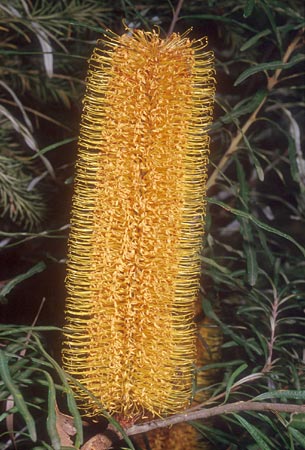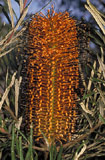|
[Front Page] [Features] [Departments] [Society Home] [Subscribe]

Favourites - 1
Contributions from readers are invited for this new series on their favourite species, cultivar, hybrid or plant group. If you have a favourite and would like to write three or four paragraphs about it, please get in touch with the editor (sgap@ozemail.com.au). If you have a good colour photograph to accompany it, that would be great but, if not, we may be able to dig up one from somewhere!
To start the ball rolling, the editor is using his editorial prerogative to have first go. So, if your favourite is the same as mine, that's a bit sad....but you always can cheat and choose another!!
Banksia spinulosa - Hairpin banksia
Brian Walters
My wife often says, "You can't have too many banksias", and I can but agree!
I can't explain why Banksia spinulosa is my favourite....I only know that it held that position 20 years ago and nothing has happened in the interim to change the ranking. None of the spectacular grevillea cultivars, hybrid kangaroo paws and other desirable cultivars that have appeared in the intervening years have changed my opinion.
If anything, B.spinulosa has gone up in my estimation due to the numerous new cultivars of the species that have appeared in that time. These days it's possible to obtain a range of forms from semi-prostrate to small trees (if I can cheat slightly and include B.cunninghamii.....which is not really cheating as many people still lump that species into B.spinulosa.)
By judicious selection it's possible to have species flowering between early autumn and spring with their spectacular candles of yellow or orange. The flowers, of course, are laden with nectar and birds find them irresistible. Then there is the variation in the colour of the hooked styles - black, red, orange and yellow are regularly seen.
Added to its many other attractions is its hardiness. It seems to tolerate a range of soils provided drainage is reasonable and it will grow in full sun through to dappled shade in coastal areas and in the mountains. Most of the forms available are lignotuberous (ie. they have a woody swelling at the base from which they can regenerate after fires). These forms can be pruned hard to ground level if necessary. However, don't try this with B.cunninghamii - it's not lignotuberous.
I could go on but here's a short list of some of the forms available.
| Form |
Habit |
| "Birthday Candles" |
0.5 m high x 1 m across; short, orange spikes with reddish styles. |
| "Coastal Cushion" |
0.5 m high x 1.5 m across; yellow spikes with maroon styles |
| "Stumpy Gold" |
0.4 m high x 1.2 m wide; golden flower spikes |
| "Lemon Glow" |
1.5 m x 1.5 m; lemon yellow spikes with yellow styles |
| B.cunninghamii |
2.5-4.5 m x 2-3 m; usually yellow spikes with black styles |
|
 |
One of the most popular of the recent releases, "Birthday Candles" forms an attractive small shrub which is also suitable for containers
Select the thumbnail image or highlighted name for a higher resolution image (57k).
|
 |
 |
Contrasting colours: A form of Banksia spinulosa with yellow styles (left) and the black styles commonly seen on Banksia cunninghamii (right).
Select a thumbnail image or highlighted name for a higher resolution image (45k and 44k).
|

[Front Page] [Features] [Departments] [Society Home] [Subscribe]
Australian Plants online - June 2000
Association of Societies for Growing Australian Plants
|